We use human-focused methodologies, rather than disease-focused ones, to design complex interventions for patients with chronic conditions to drive sustainable behavior change.
We understand that nobody would like to be a patient. We understand that patients are humans that, by essence, are not fully rational. Being adherent means making decisions affected by cognitive biases, habits and social norms, which can be influenced.
Our work in 4 steps

color
1. Understand behaviors
We use a similar methodology as the one used for patient journey. Desk and in field research allow us to better identify the specific adherence issues for instance how patients perceive their illness and their treatments, if there are knowledge gaps or how well do patients think they are self-efficient. All the behavioral insights and issues discovered in this phase will be used in the design one.
color
2. Design the intervention
For us, the design of the intervention is the most important. We partner with specialists with practical experience in behavioral sciences applied to healthcare, IT&C specialists, copy-writers and graphic designers to build relevant solutions.
As a one-size-fits-all approach is not suitable and resources are not limitless, we ensure the intervention has a good balance between efficiency (scalability) and efficacy (tailoring).
We design behaviorally based segmentation to identify specific patient sub-groups and model educational messages and interventions specific to each subgroup: sequence, frequency, content format and communication channels that will resonate with each patient
Relevant KPIs are defined during the design stage and we ensure we comply with all the local regulations.
As we provide end to end services, we design all the content and materials needed to engage stakeholders along the value chain (client’s employees, HCPs, patients, caregivers).
color
3. Implement the intervention
We ensure excellence in execution by using reliable technology, hiring the right people, improving their skills continually and implementing solid Quality Assurance processes.
color
4. Evaluate and improve
Established metrics, both quantitative and qualitative are continuously assessed in order to manage the services and to show their impact.
Based on these metrics and the new real-world insights discovered, services are fine-tuned, improved and new ones may be designed and implemented.


